AMD Radeon R9 Fury X 4GB Review
Can AMD's complex Fiji GPU, groundbreaking memory tech and closed-loop cooler generate enough performance to usurp Nvidia’s GeForce GTX 980 Ti?
Meet The Radeon R9 Fury X
Without question, the first thing you’ll notice about the Radeon R9 Fury X itself is the card’s length. At least, that’s what caught my eye. Measuring a little over 7.5” long, it sheds more than three inches compared to AMD’s reference Radeon R9 290X; it’s also about three inches shorter than the GeForce GTX 980 Ti.
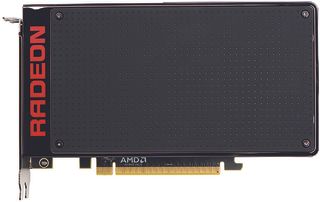
There is no cooling fan either. AMD might have gotten away with the same thing on its Radeon R9 295X2 as well, but that card was based on an Asetek system that needed help keeping the PCB-mounted memory modules and voltage regulation circuitry cool. This time around, the memory sits at almost the same height as the GPU, making it easier to cool with the same plate responsible for dissipating Fiji’s waste heat. Other sensitive components come in contact with this piece of metal as well. So, the liquid cooler can do its job unassisted.
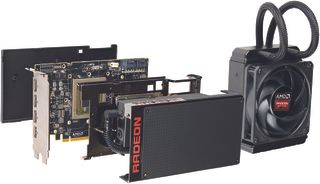
AMD says it teamed up with Cooler Master for Radeon R9 Fury X, tapping a 120mm Nidec cooling fan to blow through the radiator. Whereas the hoses AMD used on its R9 295X2 were bare rubber, they’re now covered in wire loom, more closely resembling leads coming from your power supply. It’s a nice aesthetic touch that helps the peripheral radiator blend in.
Company representatives claim that this is the sort of design enthusiasts want and that they’re delivering a value-add by integrating the liquid cooling so many power users add after the fact. Though this may be true in some cases, AMD is necessarily leaning on another brute force approach to keep its 275W board healthy without the din an air cooler would generate (if it’d even be viable on a 7.5” card). The solution works, and it’s definitely more elegant than R9 295X2. However, given a choice, this enthusiast would prefer a self-contained package. Value here is a red herring; liquid cooling enables Fury X’s performance profile, regardless of how much it cost AMD.
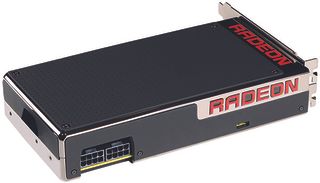
Of course, the benefit of a big circuit is lots of thermal headroom. AMD says its solution enables up to 500W of capacity, well beyond the card’s 275W typical board power. In theory, that rating should fit within the bounds of one six- and one eight-pin power connector (plus the 16-lane slot), which add up to 300W. But AMD uses two eight-pin connectors instead.
As with its Radeon R9 290-series cards, AMD adds a dual-BIOS switch at the top of Fury X. The two BIOS files are identical this time around, though. The second one exists as a backup to recover factory settings should the first become corrupted.
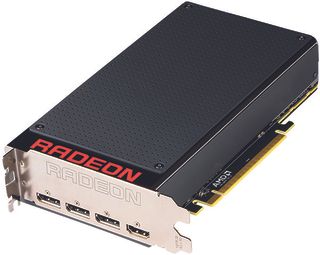
A lack of air moving through Radeon R9 Fury X means there’s no need for I/O bracket ventilation. Aside from the display adapters, the rear panel is solid with a Radeon logo etched into the metal. It’s a nice look, really. You’ll find three DisplayPort connectors and one HDMI output back there, but no DVI. And because Fiji’s display controller is limited to HDMI 1.4, that interface probably won’t see much use. Perhaps the Fury Nano will be better suited to the HTPCs most likely to utilize HDMI.
Stay on the Cutting Edge
Join the experts who read Tom's Hardware for the inside track on enthusiast PC tech news — and have for over 25 years. We'll send breaking news and in-depth reviews of CPUs, GPUs, AI, maker hardware and more straight to your inbox.
The body of Radeon R9 Fury X is unique from any of AMD’s past efforts. We can tell the company is putting more thought into industrial design and applaud it wholeheartedly. Because there is no fan and no ventilation, the card is pretty much a closed-up rectangular box. According to AMD, its shroud consists of die cast aluminum covered in a matte black soft-touch material and a polished metal, which we’ve heard referred to as nickel-plated chrome and a black nickel-mirrored finish. Whatever it is, fingerprints show up readily, so watch where you touch during installation or be ready with a soft rag.
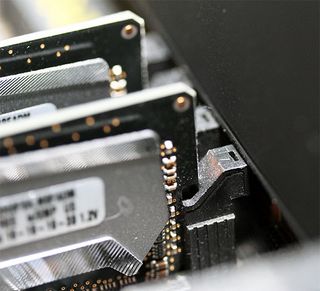
AMD says that the Fury X’s front plate is removable, giving customers the flexibility to manufacture personalized alternatives. We were more intently focused on the rear plate, though. The card’s frame sticks out more than 1/8” from the PCB—farther than the plate on GeForce GTX 980. As (bad) luck would have it, our reference motherboard, MSI’s X99A Xpower AC, has memory slots that back right up to the first PCIe slot. They’re far enough away that a GeForce GTX 980 with its back plate drops right in. However, the Radeon R9 Fury X hangs up on them before seating, giving you two options: wedge it in at an angle or pick another slot. We’re not sure how many other motherboards might encounter compatibility issues, but this becomes one of those concerns you’ll have to research before making your purchase.
Current page: Meet The Radeon R9 Fury X
Prev Page Introduction Next Page How We Tested Radeon R9 Fury X-
endy0307 very nice just what i wanted since i dont to nvidia for personal reasons, now i never buy into hype either i tend to wait it out fofr revisions but this one is going to be my 2 year card,.since i only game at 2k and d dalarererady havefrereesyync monitotoReply -
wh3resmycar same here, disappointment... guru3d has calculated tdp around 300w for this card. not good at all.. 4096-bit and this is it? once nvidia goes HBM i don't know how AMD will be able to compete with it.Reply -
Free2play_noobs What's the driver version You have used for this review ? Has AMD released any separate driver for Fury X?Reply
Most Popular

